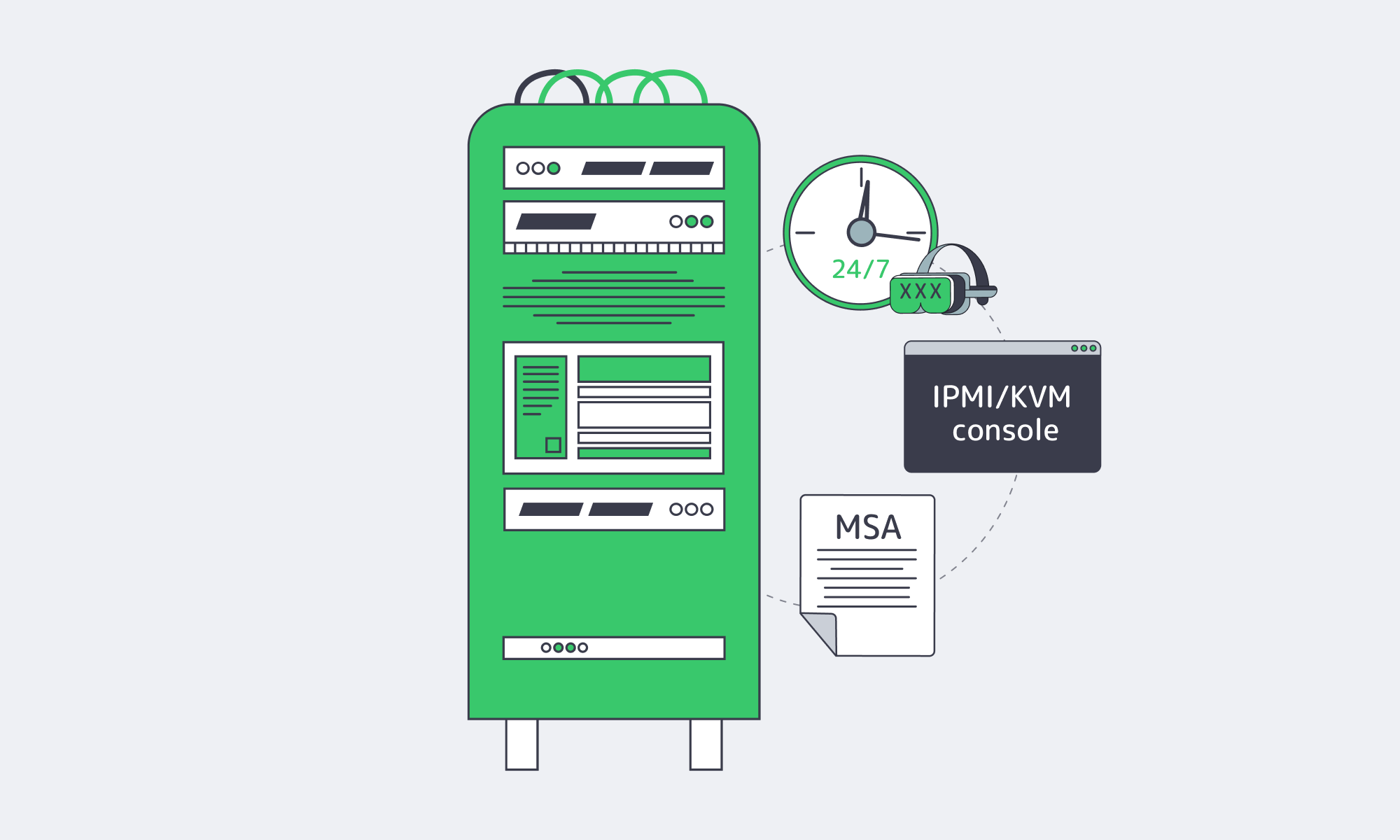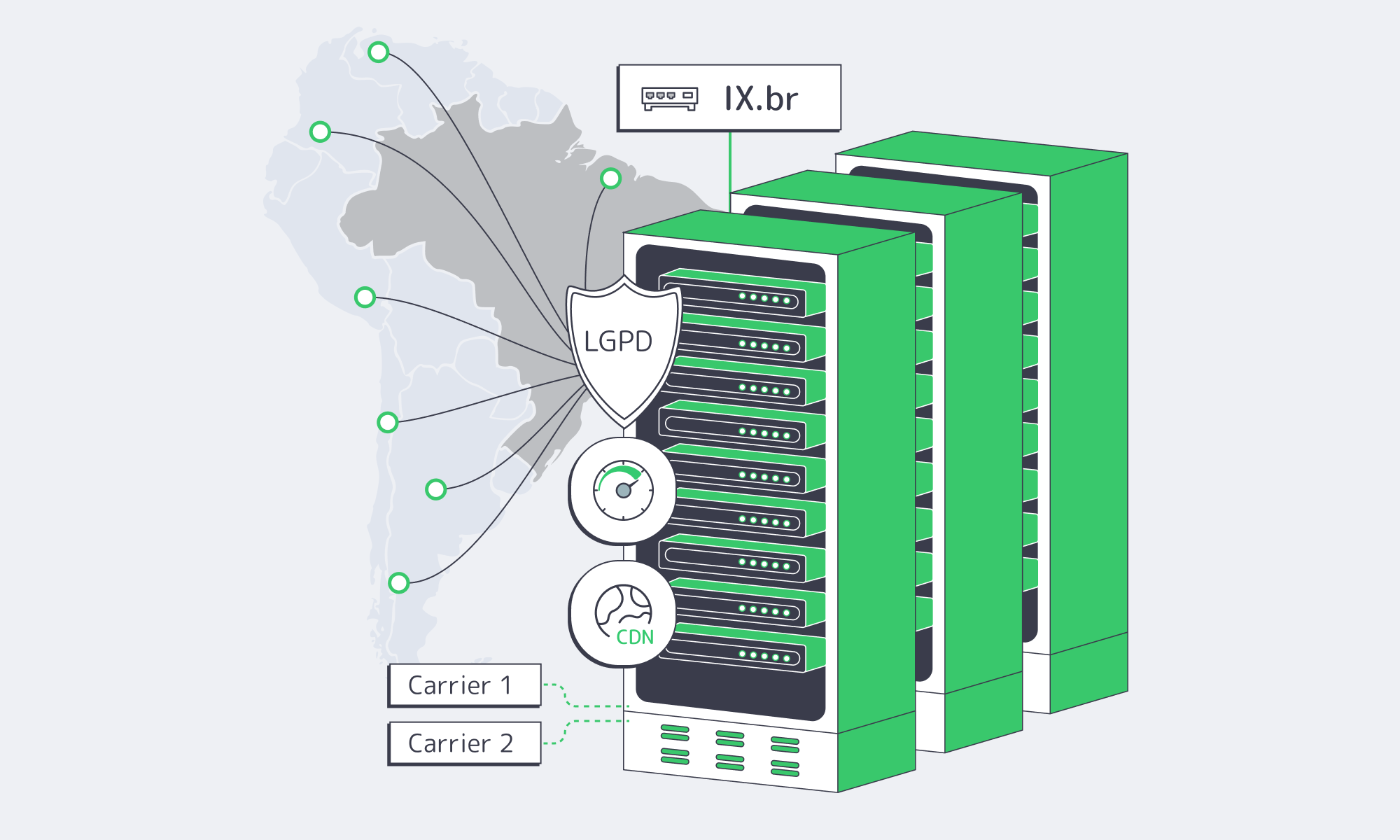Blog

Faster Apps & Easier LGPD Compliance with Dedicated Servers in Brazil
Why Rent Dedicated Servers in Brazil Instead of Serving from Abroad?
The distance penalty is real. Each transoceanic hop adds tens to hundreds of milliseconds to every API call, UI render, fraud check, or video segment fetch. Brazil has roughly ~183 million internet users and internet penetration around ~86%, so even small latency deltas compound into large revenue and engagement impacts at national scale. Hosting application origins on a Brazil dedicated server keeps packets on-net and close to users.
Representative RTTs relevant to Brazil hosting placement

Local vs. cross-Atlantic and to the U.S. East. Local round trips typically stay in the tens of ms.; EllaLink enables fast EU paths; São Paulo↔Miami checks routinely sit ~100 ms.
Two structural factors tip the scales further toward local compute:
- Brazil’s internet exchanges are world‑class. IX.br aggregates dozens of IXPs nationwide, peaking >31 Tbps; São Paulo alone exceeds 22 Tbps and connects >2,400 ASNs, so peering locally shortens paths to the last mile.
- Modern subsea routes reduce overseas detours. The EllaLink system provides a direct EU–BR corridor with <60 ms RTT between Brazil and Portugal—useful for cross-regional services and BCP, but still slower than in‑country origins for Brazilian end users.
How Do São Paulo Proximity, IX.br Peering, and Multi‑Homed Transit Cut Latency?
Put your origin where Brazil’s networks meet. In São Paulo, you can peer at IX.br with thousands of ISPs and content networks, keeping traffic local and avoiding trombone routes through distant transit hubs. Multi‑homed upstreams add deterministic performance: one carrier may minimize northbound paths to North America while another optimizes West‑East flows across Brazil; BGP can prefer the best‑performing, lowest‑loss path and fail over instantly on faults. This combination—São Paulo adjacency + IX.br peering + multi‑homed transit—is why a Brazil dedicated server routinely delivers single‑ to low‑double‑digit millisecond experiences nationwide while maintaining resilience against congestion and fiber cuts.
Which Regulatory “Rules of the Road” Are Easier to Meet with In‑Country Hosting?
Brazil’s LGPD and recent ANPD resolutions set clearer guardrails for cross‑border transfers of personal data, including standard contractual clauses (SCCs) and related compliance mechanics. Keeping regulated data in‑country—on a Brazil‑based dedicated server—reduces reliance on SCCs and lowers the risk and overhead of cross‑border flows. In addition, incident rules impose tight notification timelines to the ANPD and data subjects (three business days in certain steps), making local control and observability of your stack a pragmatic choice.
What Does the Market Signal Say About Repatriating Steady Workloads?
As cloud adoption has matured, a record share of CIOs report plans to repatriate some public‑cloud workloads back to private/dedicated infrastructure—driven by cost, performance, and compliance. Recent Barclays data pegs repatriation intent in the low‑80s percent range—the highest on record—with storage and databases among the most‑moved workloads. In parallel, spending expectations on public cloud remain high, underscoring a pragmatic hybrid reality rather than a single‑stack dogma.
How Does TCO Look When You Shift Origin Compute to a Dedicated Server in Brazil?

Three cost levers dominate: always‑on compute, egress, and control overhead. Dedicated hosts exchange variable instance pricing for fixed monthly economics and large, predictable bandwidth allocations—attractive when origin traffic and job queues run 24/7. You also reclaim hardware‑level tuning (I/O, NUMA, storage layout) and no noisy‑neighbor penalties, which stabilizes tail latency without over‑provisioning. For global platforms with Brazilian user concentrations, the combination of lower RTTs (fewer retries, faster TLS/HTTP waterfalls) and fixed‑rate bandwidth can materially reduce both SLO breaches and monthly infra volatility.
Local vs. remote origin for Brazil (at a glance)
| Hosting Location | Typical Latency for Brazilian Users | Data Sovereignty & Compliance |
|---|---|---|
| Remote Cloud (US/EU) | ~100 ms+ RTT (e.g., São Paulo↔Miami ≈106 ms) | Cross‑border transfers require SCCs and added LGPD controls |
| Local Dedicated Server (BR) | Tens of ms within Brazil | Data stays in BR; fewer cross‑border obligations |
Sources for representative values: WonderNetwork pings and ANPD/Trade.gov summaries.
The Pragmatic Migration Path from Hyperscale Cloud to Dedicated Servers
You don’t need a “big bang.” Migrate with deliberate, low‑risk steps that preserve uptime and auditability:
- Stand up a parallel origin in São Paulo. Choose a dedicated server in Brazil sized for your peak request/second and storage IOPS profiles. Establish site‑to‑site VPN or private interconnect to your cloud VPC to sync data and logs.
- Replicate state methodically. Bulk‑load historic datasets over high‑bandwidth links (or offline media if needed); then switch to near‑real‑time streaming for deltas. Multi‑homed transit and IX.br peering will keep sync jitter low.
- Cut over with your CDN. If you already run CDN edges in Brazil, point them to the new São Paulo origin and ramp traffic with weighted DNS or header‑based routing. Cache‑hit traffic moves first; dynamic traffic follows after SLO burn‑in.
- Retain a thin cloud footprint. Keep object storage, backups, or DR replicas in the cloud while production origin sits on a Brazil based dedicated server. This avoids lock‑in while giving you regional autonomy.
The Operating Model: MSAs, Remote Management, and a 24/7 NOC

MSAs. With dedicated hosting in Brazil, you contract directly for the outcomes that matter—data location, support scope, hardware replacement windows, access controls, log retention, and peering policy. A well‑drafted MSA clarifies who can access what (and from where) and how incidents are handled under LGPD.
Remote management. Dedicated servers in Brazil shouldn’t mean hands‑on‑keyboards in a cage. Expect IPMI/KVM for full out‑of‑band control so your SREs can reimage kernels, manage firmware, or capture consoles without a truck roll.
24/7 NOC. Network‑aware ops is non‑negotiable for low‑latency applications. Look for round‑the‑clock support with hardware replacement SLAs measured in hours and engineers who understand BGP, peering, and routing health—because a fast origin is only as reliable as the path to it.
Latency and Compliance in Brazil: the Bottom Line
Placing origins on a dedicated server in Brazil—ideally in São Paulo with IX.br peering and multi‑homed transit—delivers the fastest user experience your stack can realistically achieve in the country. Traffic takes direct, local paths to last‑mile ISPs; dynamic requests no longer backhaul across oceans; and packet loss variability drops with fewer long‑haul segments. For regulated workloads, keeping personal data within Brazil simplifies LGPD posture and avoids much of the SCC overhead that accompanies cross‑border data transfer. The commercial signals point the same way: many technology leaders are re‑balancing steady workloads toward dedicated or private infrastructure to regain cost control and performance predictability.
Enabling Fast, Compliant Dedicated Server Launches in Brazil

Melbicom is preparing data center presence in São Paulo and is collecting early‑access demand for dedicated servers. Until go‑live, we can stage your Brazil launch using the same architecture we’ll deliver at turn‑up: IX.br peering plans, multi‑homed transit, and in‑country data handling aligned to LGPD—fronted today by Melbicom CDN nodes across South America. At cutover, we shift the origin to São Paulo via a controlled migration. Unlike others, Melbicom operates its own global network, offers high‑bandwidth options (up to 200 Gbps per server, where supported) and custom hardware almost anywhere, and runs a 24/7 NOC with IPMI/KVM and BGP/BYOIP readiness. Share your traffic volumes, compliance needs, and hardware/network specs now; we’ll reserve capacity and return a Brazil‑ready design.
Dedicated Hosting in Brazil, Made Flexible
- Deploy fast: We’re collecting detailed requirements now (traffic profiles, IX.br peering needs, carrier preferences, rack‑level constraints) to pre‑stage capacity and shorten activation windows at launch. Our 24/7 NOC and remote‑hands workflows are already in place to support first installs and early production.
- Customize freely: Specify CPU/RAM/NVMe/GPU mixes, NICs, and storage layouts; request BGP/BYOIP and routing policy; define private L2/L3 overlays. Melbicom’s global baseline includes per‑server bandwidth up to 200 Gbps (location‑dependent); we’ll bring the same performance mindset to São Paulo at go‑live.
- Operate globally: Keep a consistent operating model across Melbicom’s 20 Tier III/IV DC footprint and a CDN in 50+ locations. Build once (automation, monitoring, IaC), then roll out in Brazil without re‑tooling. Our own network means predictable routing and the ability to engineer paths—not just rent them.
- Control TCO: Fixed‑price dedicated servers with generous bandwidth allocations reduces egress shock and keeps costs legible for steady workloads. Use CDN edges in LATAM today to cut cross‑border traffic; shift the origin to São Paulo at launch to minimize long‑haul dependencies.
- Engineer for resilience: Pre‑plan IX.br peering, map multi‑homed transit (at least two upstreams), define failure domains, and codify playbooks with the 24/7 NOC. Remote management (IPMI/KVM) and hardware replacement procedures are standard, so operational recovery doesn’t hinge on local hands.
- Experience freedom: Simple onboarding, clear MSAs, transparent control surfaces, and access to network engineers—not ticket ping‑pong. We’re structured for no vendor lock‑in and no shared tenancy on your compute.
Be the first to host in Brazil on special terms
Share your traffic and hardware needs to reserve São Paulo capacity. We’ll follow up with launch timelines and options for peering, transit, and compliance.